
IBM has just released the next version of its Cognos Analytics enterprise platform, version 11.0.6 (or R6). This release represents the right time to upgrade if you are on Cognos 10.X as it is almost at the end of its support life. The release aims to further extend into the areas of functionality and ease of use, and to move further towards self-service capabilities for end users, complete with the full integration of Dashboard with OLAP data sources. Below are some of the highlights.
For the long-term Cognos customers, Dashboards now support OLAP sources such as Powercubes, TM1 (also Planning Analytics), DMR (Dynamically Modelled Relational), and Dynamic Cubes.
From the cube structure, users can select hierarchy levels from the metadata tree and drag into the canvas to display data at the selected level, as well as dynamically drill up/down on the hierarchy structure. See screenshots below from a TM1 cube based Dashboard:

From the visualisation, users can use the navigate icon to access the hierarchy levels and jump directly to a level instead of continually drilling up/down on the hierarchy path.
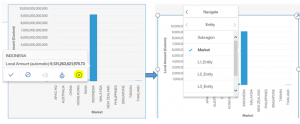
Another useful feature is the ability to drag any hierarchy/level/attribute into the filter box and directly access the members to select filter value(s). The screenshot below shows the result of the Month dimension being dragged into the Local filters box of the visualisation, exposing the members that can be selected to filter the visualisation. See screenshot below from a Powercube based Dashboard:

More boundaries can now be drawn and visualised with the integration of Pitney Bowes polygons. Maps, which now supports over 200 countries, can have data associated with and rendered down to the level of:
Data can be plotted down to the suburb level:
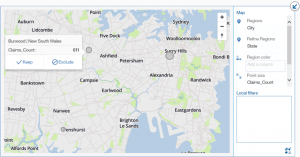
Maps can zoom down to street level and main localities:

There is also a feature to list ambiguous or unrecognised locations that you can then resolve by using the ‘refine regions’ property to put the location in context of a parent level location.
The interactivity between widgets on a dashboard can now be easily controlled by clicking on the connections icon from the application bar. Use the connect/disconnect icons to control the interactivity.
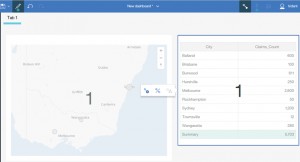
The long-held bug bear of freezing column headings is now handled more eloquently with the addition of a property in the list object to control the fixed height of the list, in authoring mode. Used in conjunction with the rows per page property, a scrollable bar will now be available automatically for the user to scroll through the list.

Report authors are now able to modify data module queries like a normal reporting package (and by the way, framework manager packages are now supported in data modules). Authors can access the expression editor to create custom calculations, apply parameterised detail filters, and define drill through definitions from a data module sourced report to a target report.
Portal customisations has been extended to allow the administrator to set a custom folder for individuals or roles to appear on their navigation bar. Access this option from Manage > Accounts:

Once set, the user(s) will have the custom folder appear in the navigation bar:

You can now create a shortcut to a report, report view, dashboard, module or folder. Also new to R6 is the ability to create a report view directly from the context menu, without the need to run the report first.
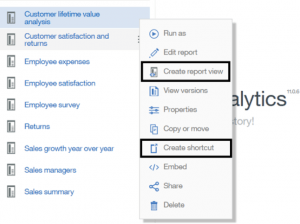
Finally, users will now be able to connect directly to Google BigQuery to access Google Analytics, Adwords and others, via JDBC driver. Support also covers Google Cloud SQL to access the Google cloud database.
By connecting to BigQuery, either through data module or as a Framework Manager package, users can quickly produce visualisations in Dashboard, and for report authors in the Reporting tool. The screenshot below shows a dashboard using public sample data from BigQuery. Notice data context awareness, so that dragging in the ‘State’ will automatically generate a map visualisation:

The interface to Data Server has also been improved to simplify the creation of a new data server with sample JDBC URLs (specific to the vendor) provided, and additional information provided when testing the connection.
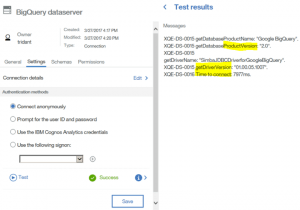
As we are fast approaching the end of support for Cognos 10.2.X (April 2018) there has never been a better time or more compelling reason to start upgrading to Cognos Analytics. Those already on CA will be sure to find enough gems in this release to seriously consider upgrading.
If you would like to find out more on the features described in this blog and other new features in R6, or are considering upgrading, feel free to contact us at Tridant for professional guidance.
Copyright © Tridant Pty Ltd.